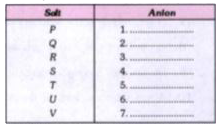The addition of ferric hydroxide solution to arseneous sulphide solution results in the precipitation of both.
This is possible only in case equimolar solutions (solutions with same number of moles) are mixed. Since the ferric hydroxide sol carries positive charge and arsenic oxide sol is negatively charged on mixing they will get their charge neutralized and will be coagulated.
Topper's Solved these Questions
- SURFACE CHEMISTRYBOOK - VMC MODULES ENGLISHCHAPTER - SURFACE CHEMISTRYEXERCISE - SOLVED EXAMPLES
15 Videos
- SURFACE CHEMISTRYBOOK - VMC MODULES ENGLISHCHAPTER - SURFACE CHEMISTRYEXERCISE - IN-CHAPTER-A
10 Videos
- SURFACE CHEMISTRYBOOK - VMC MODULES ENGLISHCHAPTER - SURFACE CHEMISTRYEXERCISE - JEE Advanced (Archive)
10 Videos
- STRUCTURE OF ATOMBOOK - VMC MODULES ENGLISHCHAPTER - STRUCTURE OF ATOMEXERCISE - IN-CHAPTER EXERCISE-F
7 Videos
- THE SOLID STATEBOOK - VMC MODULES ENGLISHCHAPTER - THE SOLID STATEEXERCISE - EXERCISE-J
10 Videos
Similar Questions
Salts P, Q,R,S,T,U and V undergo reactions (i) to (vii) respectively. Identify the cation present in these salts on the basis of these reactions. Tabulate your answer in the formate given below.
(i) When the salt Pis heated with sodium hydroxide solution a vigorous reaction takes place and a colourless gas is evolved with a pungent and suffocating smell that brings tears in our eyes. The evolved gas gives dense white fumes with a moist glass rod depped with hydrochloric acid.
(ii) Addition of sodium hydroxide solution to a solution of salt Q gives a thick white precipitae which is soluble in excess of sodium hydroxide solution to form a clear solution.
(iii) Addition of ammonium hydroxide solution to a solution of salt R gives a dark blue precipitate which is soluble is excess of ammonium hydroxide solution to form an intense deep blue solution.
(iv) Addition of ammonium hydroxide solution to a solution of 5 gives a dirty green [bottle green] precipitate which is insoluble even in the excess of ammonium hydroxide solution.
(v) Addition of ammonium hydroxide solution to a solution of T gives a reddish brown (rust precipitate] precipitate which is insoluble even in the excess of ammonium hydroxide solution.
(vi) Addition of ammonium hydroxide solution to a solution of V gives a geletaneous white precipitate which is soluble in excess of ammonium hydroxide solution to form a clear solution.
(vii) Addition of ammonium hydroxide solution to a solution of V gives no precipitate but it gives a chalky white precipitate with sodium hydroxide solution which is insoluble even in the excess of sodium hydroxide solution.

View SolutionA colloidal solution of arsenious sulphide is most readily coagulated by the addition of a normal solution?
View Solution
Knowledge Check
Addition of ferric chloride solution to ferric hydroxide precipitate results in
APeptizationBProtectionCFlocculationDDialysisOn addition of excess of sodium hydroxide solution to stannous chloride solution, we obtain
ASn(OH)2BSnO2.H2OCNa2SnO2DNone of theseAddition of excess of sodium hydroxide solution to stannous chloride solution, we obtain:
ASn(OH)2BNa2SnO2CNa2SnO3DSnO2.H2O
The addition of NaOH to Cr3+ solution produces the precipitate of
View SolutionOn addition of excess of sodium hydroxide solution to stamnous chloride solution, we obtains:
View SolutionA colloidal solution of arsenious sulphide is most readily coagulated by the addition of a normal solution ?
View SolutionA colloidal solution of arsenious sulphide is most readily coagulated by the addition of a normal solution?
View SolutionThe addition of NaOH to Cr3+ solution produces the precipitate of
View Solution
